Speech The Development of Asia: Risk and Returns for Australia

Philip Lowe [1]
Assistant Governor (Economic)
NatStats 2010 Conference
Sydney –
- Audio 13.59MB
- Presentation Slides
It is a pleasure for me to be able to support the work of the Australian Bureau of Statistics (ABS) by participating in this year's NatStats Conference. The conference itself is evidence of the ABS's commitment to high-quality statistics. It is also evidence of the Bureau's commitment to making sure that its statistics remain relevant as the economy evolves over the years ahead.
Today, I would like to talk about that expected evolution and some of the issues that it raises.
My central thesis has two elements. The first is that the medium-term prospects for the Australian economy look to be more positive than they did some years back. This is partly the result of policy choices that have been made within Australia, but it also reflects the development of the economies in Asia. The second element is that as Australia's medium-term prospects have improved, the risks facing the economy have also changed and these risks need to be managed. In my time today, I would like to explore both these elements.
The Medium Term and the Development of Asia
As is now well understood, Australia has come through the global downturn in good shape. Not only has the business cycle here been relatively muted compared with elsewhere, but our medium-term prospects look to be brighter than those of most other advanced economies. They also look brighter than they did a decade ago.
For many years it seemed that Australia was inexorably slipping down the global league tables. The prices of our exports were gradually falling relative to the prices of our imports, and there was little optimism that this would change. And it was only a decade ago that Australia was viewed by some as an old-fashioned, low-tech economy, relying on its natural resources instead of developing new technologies.
Today, things look quite different. While there are continuing uncertainties about the near-term outlook, there is more optimism about medium-term prospects than there has been for some time. The prices of commodities have risen substantially. Investment in Australia is high and Australian assets are again viewed as attractive by international investors.
I have talked on previous occasions about the factors that helped Australia through the global downturn and I don't plan to revisit those today. Rather, I want to focus on why this change in perceptions about medium-term prospects has occurred and, in particular, the role that the development of Asia has played.
At a general level, the importance of Asia to Australia is now well understood. Despite this, it remains the case that the financial news from the United States and Europe dominates our newspapers and our airwaves. With this constant flow of information about the North Atlantic, it is sometimes easy to forget just how profound – and important to Australia – are the structural changes taking place in Asia.
Two of these changes are particularly important. These are the twin processes of urbanisation and industrialisation. As the countries of Asia have urbanised and industrialised, the demand for infrastructure has grown very strongly. When people move to the cities, new dwellings need to be built, and as living standards rise, so too does the quality of dwellings constructed. The growth of urban centres also requires the building of communication and transport networks, with the demand for roads, bridges, railways etc rising.
All this development requires raw materials. In particular, it requires steel to build the apartments in which the new city dwellers live and to build the infrastructure that supports those cities. For example, a typical 90m2 apartment in China requires about six tonnes of steel, and 10km of metropolitan subway requires around 75,000 tonnes. On average, every tonne of steel that is produced requires around 1.7 tonnes of iron ore and over half a tonne of coking coal, and Australia is in the fortunate position of having ample low-cost, high-quality supplies of both. And with higher energy consumption also a feature of industrialisation, we are in the fortunate position of having large reserves of natural gas.
Not surprisingly, the strong growth in demand for raw materials in Asia has led to a large increase in the price of raw materials over the past decade. As a result, Australia's terms of trade have increased very significantly and are now at their highest level since the spike in the early 1950s when wool prices soared due to the Korean War (Graph 1).
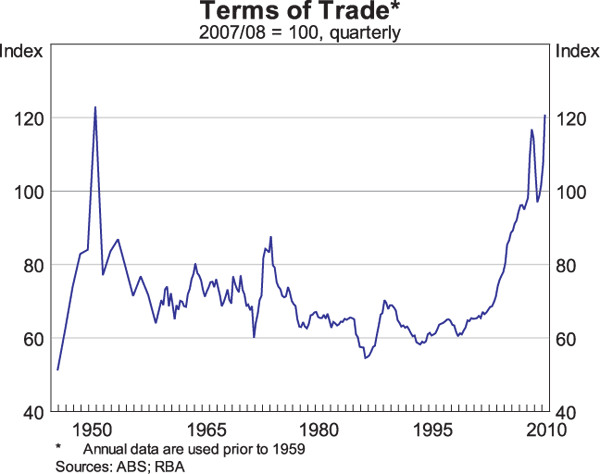
These higher prices have raised the return to capital in the Australian resources sector, and the result has been a very large increase in investment. Indeed, Australia has become one of the high-investment countries of the developed world, with the stock of physical capital estimated to have increased at an average rate of around 5 per cent over recent years. By way of contrast, in many other advanced economies, including the United States, the level of investment has been only a little above that needed to offset the depreciation of the existing capital stock (Graph 2).
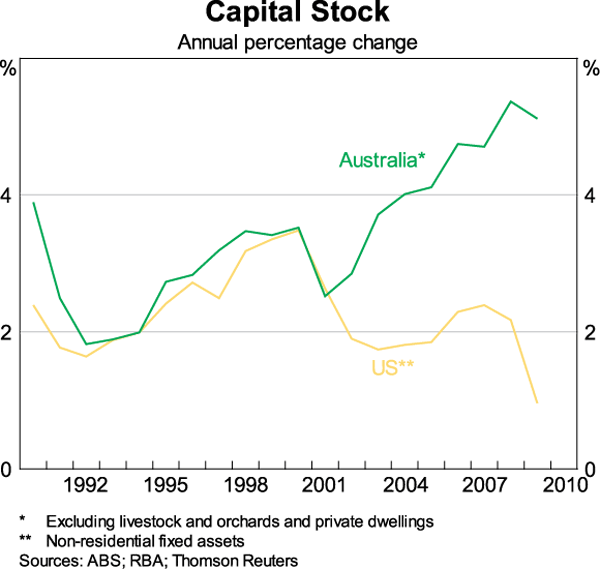
When discussing the impact of Asia on Australia over recent years, the focus has rightly been on China. The transformation that has been occurring there is truly remarkable and it is reshaping the global economy. Over the past three decades, the proportion of the Chinese population living in urban centres has more than doubled to almost 45 per cent (Graph 3). While there have been a couple of historical examples of other countries urbanising as quickly, the sheer number of people migrating to urban centres is unprecedented in human history – over the past 30 years, nearly 400 million Chinese citizens (almost 20 times the population of Australia) have moved to cities. As a result, there are now around 170 Chinese cities with more than a million residents, compared with only around 35 in Europe. And the urbanisation process still has quite a long way to run, with another 300 to 400 million people expected to move from the country to the city over the next 20 years.
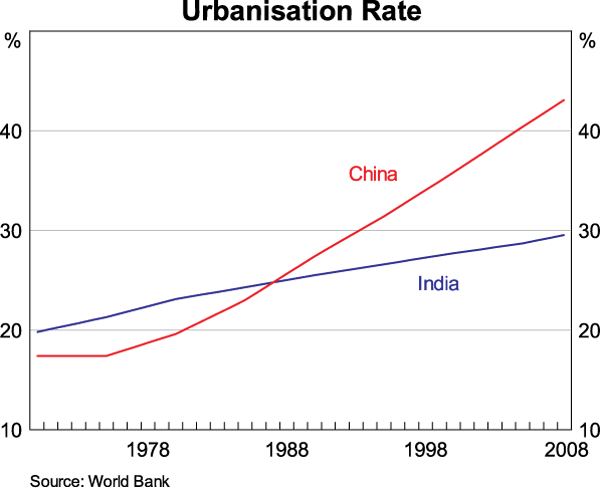
These developments in China are being closely observed in Australia, including at the Reserve Bank. A decade or so ago, we spent a lot of time puzzling over why quarterly movements in Australian GDP were so highly correlated with quarterly movements in US GDP. We don't puzzle over this anymore – not because we solved the puzzle, but because the correlation has fallen (Graph 4). At the same time, the correlation between quarterly movements in Australian and Chinese GDP has steadily increased. Clearly what happens in the Australian economy is now more dependent upon what happens in China than has been the case at any time in our past.
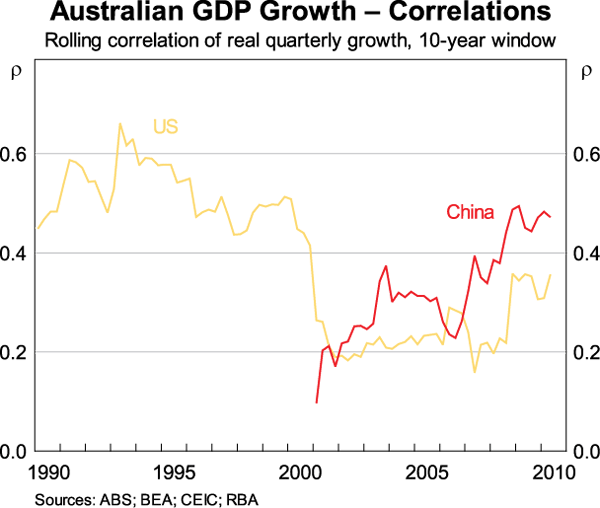
But as we think about the future, the story is broader than China. Over the years ahead, the Indian economy, which also contains more than 20 per cent of the world's population within its borders, is likely to become increasingly important to Australia. After India grew at a disappointing pace in the 1960s and 1970s, growth has picked up over recent decades, averaging 7 per cent per year over the 2000s (Graph 5). The economy has gradually opened up to foreign trade and capital, and government influence over investment decisions has been scaled back. While India will inevitably follow a different development path to that of China, the prospects for sustained solid growth look to be better than they have for many years.
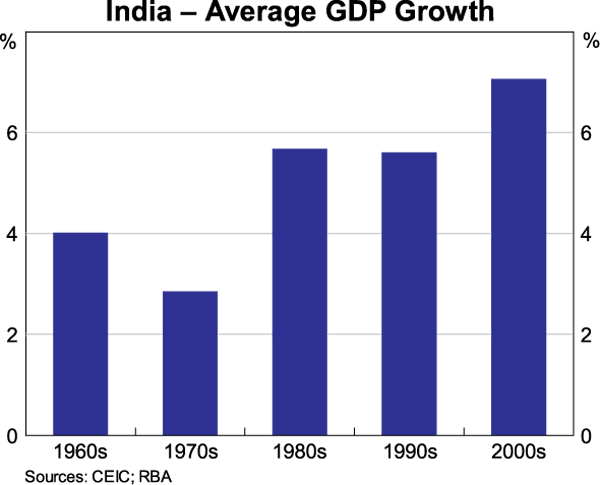
Like China, India too is urbanising. The process though is more gradual, with the number of people moving to urban areas over the past 30 years less than half that in China (Graph 3). Despite India's population currently being only marginally lower than China's, it has about 40 cities with a population of over 1 million, compared with China's 170 or so. This lower rate of urbanisation partly reflects the fact that India has not industrialised as quickly as China.
As I mentioned a few moments ago, as people move to cities the demand for steel tends to rise. Not surprisingly, in China consumption of steel has more than quadrupled since 1997, with just over half of current steel consumption accounted for by the construction sector (Graph 6).[2] Indian steel consumption has also grown, but not nearly as quickly. However, the experience of China and that of other countries that have urbanised hints at the potential growth in India. While at the moment, the bulk of the Indian population live in rural areas and investment in infrastructure has been relatively low, there is the potential for this to change over the years ahead, just as it has in China over the past 30 years. If this does indeed occur then the demand for raw materials – and steel, in particular – is likely to be very strong over coming decades.
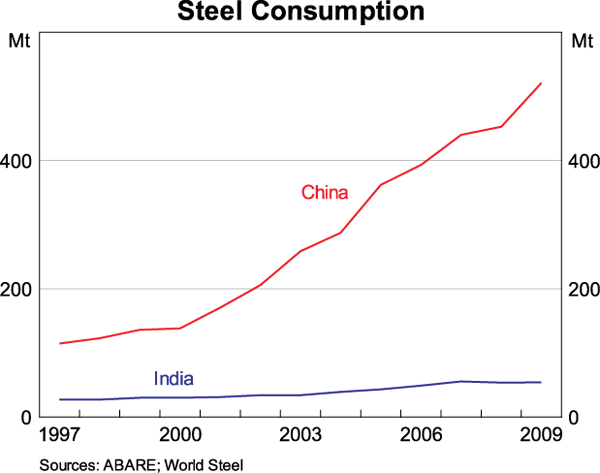
The impact of Chinese and Indian development is not just confined to the resources sector though. As countries develop and living standards rise not only does the demand for steel increase, but so does the demand for higher-quality food, and consumption of protein increases. Again, the comparison of China and India is instructive (Graph 7). As income per head in China has grown over the past 30 years, protein consumption per head has also risen strongly, almost doubling over this period. Protein consumption has also risen in India, although the increases have been much smaller due to slower growth in income per head and differences in dietary preferences.
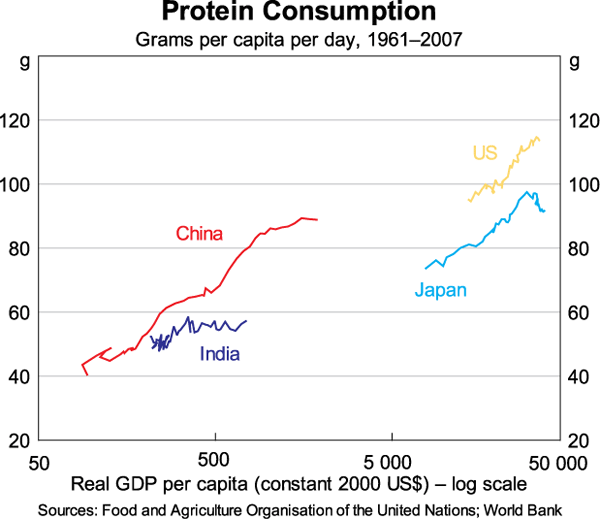
Again, over the years ahead it is quite likely that global demand for protein will grow strongly, particularly if India and China continue on their current paths. With Australia's strong history of agricultural production, this is another area where we have an advantage.
The overall impact of this growth and urbanisation of Asia can be clearly seen in Australia's international trade statistics. The four largest markets for our exports in 2009 were China, Japan, India and South Korea (Graph 8). Over the first half of 2010, around 22 per cent of Australia's exports receipts have come from China and a further 8 per cent from India. These shares have been trending higher for some time and this is likely to continue over the medium term. There has also been a large increase in the share of resources in Australia's total exports. A decade ago, iron ore and coal together accounted for around 10 per cent of Australia's total exports (Graph 9). In contrast, over the past six months, this share has been around one third, with total resource exports accounting for 55 per cent of aggregate export revenue, up from around 35 per cent in the 1990s.
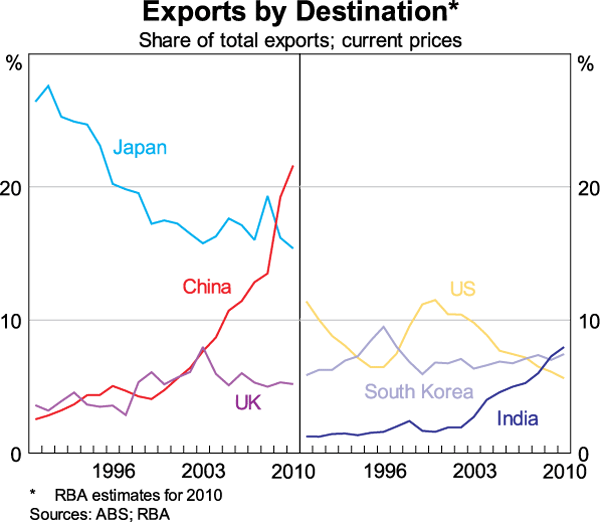
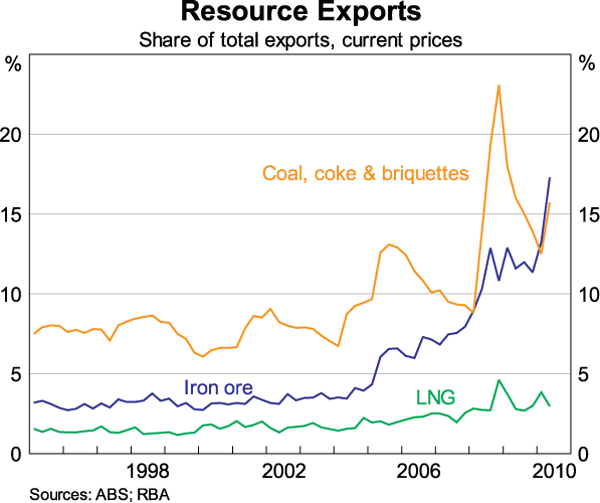
These changes in the country and product composition of our exports are very large. They are also likely to be persistent given that Asian development still has some years to run. This development means that, in aggregate, the Australian economy has the potential to do very well over the years ahead. Conditions are, however likely to differ substantially across sectors of the economy. If past experience is any guide, the growth of the resources sector will have positive spin-off effects for some industries, and rising real incomes will increase demand for a wide range of goods and services. Other industries though will find conditions more difficult due to the level of the exchange rate and the competition for labour and capital. While these differences across sectors will create some challenges, the overall medium-term outlook for the economy is a positive one.
The Changing Risks and Risk Management
I would now like to turn to the second element of my thesis – that just as the medium-term outlook has changed, so too have the risks, and these risks need to be managed.
One obvious way that the risks have changed is that the economy is more dependent than it has been in the past upon the performance of the Chinese economy and the resources sector, and I suspect that we will be saying the same thing about the Indian economy some years down the track. While, this is generally a good news story, both China and India face significant challenges over the years ahead. In China, the authorities face the difficult task of rebalancing growth away from exports and investment to domestic consumption. And in India, the burden of red-tape remains a major issue and ways need to be found to improve the country's infrastructure if the economy's potential is to be unlocked.
It would be unrealistic to assume that the growth paths in these countries will be without bumps, perhaps large ones. And these bumps will have an impact upon Australia. Nor can we assume that commodity prices will remain at their current elevated levels. New sources of supply are being discovered and developed, and there is always the possibility of new technologies reducing the demand for Australia's main resource exports.
There is very little we can do about these external risks. But what we can do is to have the right policy framework in place so that we can respond when things inevitably turn out differently to what we expect.
There are four aspects of risk management that I would like to talk about. The first is ensuring that productivity growth is strong. The second is ensuring that the economy retains its flexibility. The third is the way investment is financed. And the fourth is the rate at which national consumption increases in response to the improved medium-term outlook.
First, the importance of productivity growth. Regardless of how things develop in the countries to our north, increasing productivity in Australia remains the key to sustained increases in our living standards. Ensuring that we continue to make progress here provides insurance against the possibility that developments in Asia do not turn out as positively as we expect.
If we look back over recent years, we see that productivity growth has slowed. Since 2001, output per hour worked has increased at just over 1 per cent per year compared with over 2 per cent per year in the 1990s (Graph 10). This slowdown has occurred despite a significant rise in the economy's overall capital-labour ratio, which would typically be expected to boost average output per hour worked.
Normally, slower rates of productivity growth would lead to slower increases in average living standards. But this has not occurred. Indeed, over the past decade, growth in gross national income per hour worked has been unusually strong, averaging almost 2¾ per cent per year. The reason for this is that the prices of Australia's exports have risen relative to the prices of our imports, lifting the purchasing power of Australia's national income. With the proceeds of a tonne of iron ore we now can buy more LCD TVs and domestic services than we could a decade ago. This has allowed our living standards to increase at a faster pace than if we had to rely on productivity growth alone.
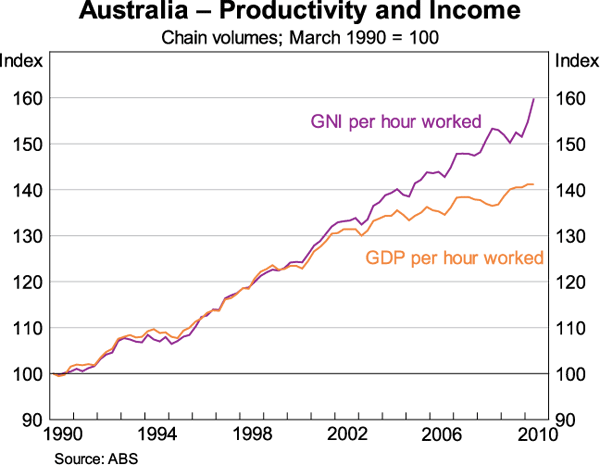
Looking forward, this situation cannot continue indefinitely. Over the next few years, commodity prices are likely to decline somewhat from their current very high levels and this will put the focus back onto productivity growth and economic reform as the drivers of increasing living standards.
The second issue is the importance of ensuring that the economy remains flexible, and can respond to unexpected developments. My colleagues at the Reserve Bank and I have spoken at length on previous occasions about the key elements here. Having a flexible exchange rate has been one of the great stabilising forces in the Australian economy over the past 30 years. Labour market flexibility is also important. So too is retaining the flexibility of both monetary and fiscal policy to respond quickly to unexpected developments. To this list, I would add the importance of having a highly trained and educated workforce. Not only does education help lift productivity, but it also makes the economy more flexible and this helps lower risk.
The third element that affects the nature of the risks is the way that investment is financed. Historically, much of the external funding for business investment has come from banks. While bank financing is likely to remain important for many firms, a greater share of investment is likely to be financed from other sources than has been the case in the recent past. This may not be welcome news for the banks, but having investment financed from a variety of different sources helps reduce aggregate risk. Over the years ahead, foreign direct investment and capital market raisings by firms in the resources sector are both likely to play a more important role than they have over the past decade. This means that some of the risks – and, of course, some of the expected returns – from the rapid increase in Australia's capital stock will be shared with foreign investors.
The fourth element of risk management is the response of domestic consumption to the improved outlook.
The textbook says that if future income prospects improve, the level of national consumption – either private or public – should increase now. But the textbook also says that the lower our appetite for risk, or the greater the uncertainty about the future, the smaller should be any immediate adjustment in consumption. It also says that the more uncomfortable we are about the possibility of a future decline in consumption if things do not work out well, the smaller should be adjustment now.
If we look back at our own economic history, the early 1980s provides a good example of what can happen if the adjustment is too quick. In the first couple of years of that decade, there was much optimism about the future of the resources sector, largely reflecting the rise in oil prices as a result of OPEC II. This optimism was translated quickly into higher wages and increased spending, and the economy grew strongly for a while. But, the optimism turned out to be short lived and the result was a significant hangover, which required a substantial adjustment in spending and real wages over the following years.
By way of contrast, the current experience looks quite different. Despite the considerable optimism about the future, household spending has been relatively restrained over the past couple of years and the appetite for debt has declined. Partly as a result, the pace of household borrowing has slowed significantly (Graph 11). One interpretation of this is that the household sector, after having increased its debt levels for many years and witnessed the problems elsewhere in the world, has a better appreciation of the risks.
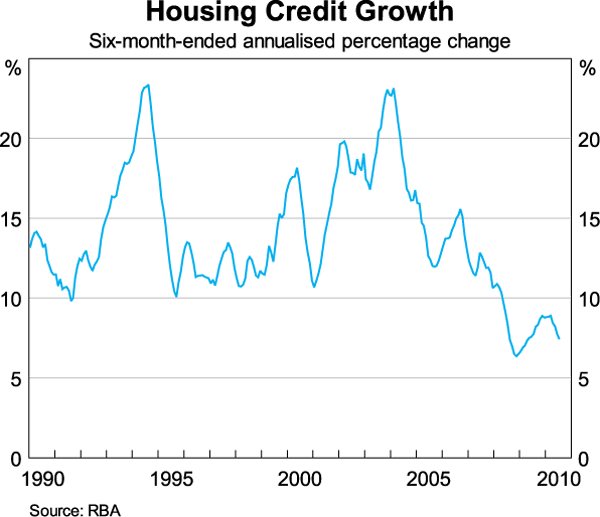
If this interpretation is correct it is likely to be a good thing from a risk-management perspective. I say this for two reasons. First, restraint now provides some insurance against the possibility that things do not work out as well as expected. In doing so, it can help lower the probability that costly adjustments will be required at some point in the future. Second, given that there is currently a relatively limited amount of spare capacity in the economy, the risk of upwards pressure on inflation would be increased if investment and consumption were both to increase very strongly over the next few years.
In summary then, while we can do little to control the external environment that Australia faces, the choices that we make on productivity, flexibility, financing and national consumption will influence the overall risk-profile of the Australian economy. So while we look forward with considerable optimism about our medium-term prospects, we also need to be alert to the risks and how we might best manage them.
Conclusion
I would like to close with just a couple of observations on what all this means for the collection of statistics.
First, we need high-quality and comprehensive statistics if we are to understand the structural changes that are taking place in the economy. One obvious area where the demand for statistics is increasing is the resources sector. We need to understand where the investment is going, and how both production volumes and prices are changing. But we also need to understand how these developments are affecting other parts of the economy – what are the linkages and how are they changing.
Second, the ABS's work is also important in helping us understand some of the risk-management issues I spoke about. We need to continue making progress on the measurement of productivity and improving our understanding of what drives increases in output per head. And on the financial side, we need to understand how the increase in Australia's capital stock is being financed and how changes in the pattern of financing are altering the economy's overall risk profile. I know these are the areas that the ABS is working on and I look forward to seeing the outcome of that work.
Thank you.